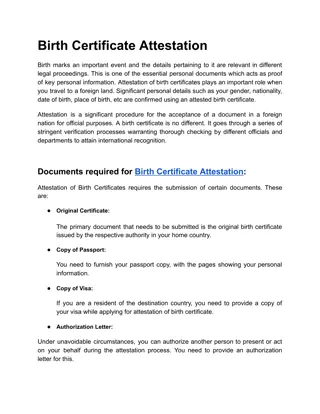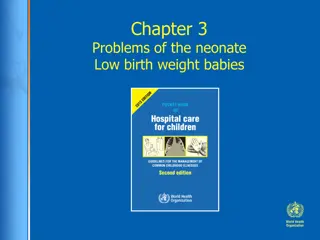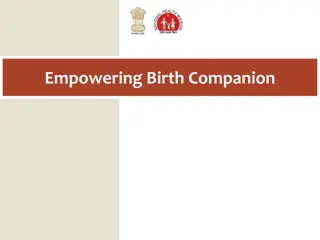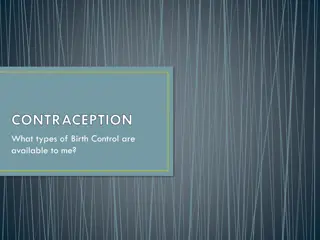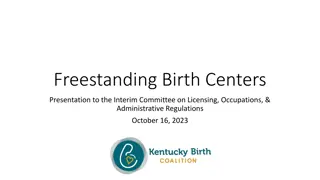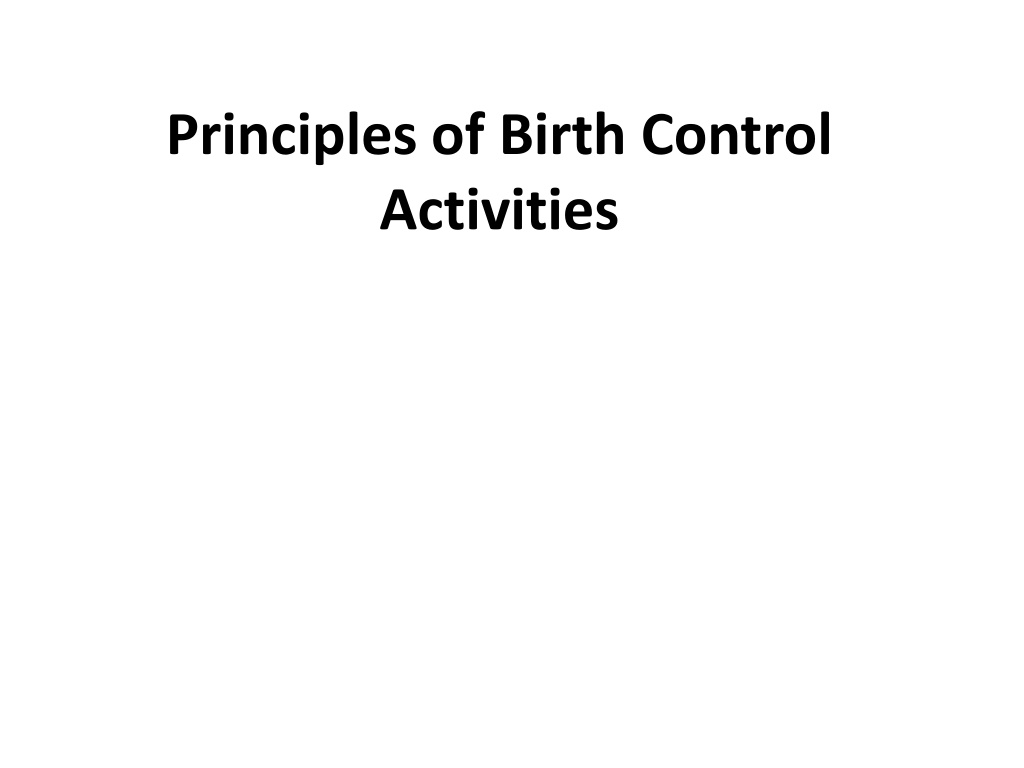
Key Principles of Family Planning Counseling and Contraceptive Methods
Discover the essential components of family planning counseling and the selection of contraceptive methods. Learn about the initial visit process, medical examinations, method selection criteria, and safety considerations to ensure informed decision-making for clients.
Download Presentation

Please find below an Image/Link to download the presentation.
The content on the website is provided AS IS for your information and personal use only. It may not be sold, licensed, or shared on other websites without obtaining consent from the author. Download presentation by click this link. If you encounter any issues during the download, it is possible that the publisher has removed the file from their server.
E N D
Presentation Transcript
Principles of Birth Control Activities
Objectives: By the end of this session, students will be able to: -Discuss what is done in initial visit for family planning. -Recognize basis for choice of contraceptive method. -Identify steps of family planning counseling. -Recognize how to be a good counseler. -Explain the approach GATHER -Differentiate between initial and return visits.
Introduction Counseling is a key component of family planning services. The time dedicated to talking with clients can help ensure correct use and satisfaction with a chosen contraceptive method. The counseling provided by an FP program plays a key role in FP uptake and continuation and is essential for ensuring informed and voluntary decision. Counseling traditionally focuses on addressing the needs of new clients. In their effort to provide information, many providers end up giving clients too much information. Clients are not prepared for what side effects to expect or for what to do when those side effects occur.
A) Initial visit 1- Preliminary health examination: History: Existing medical problems Regular medication Family history Menstrual history Obstetric history Previous contraceptive use
Examination: Physical general examination. Gynecological examination. These examinations selecting the proper safe contraceptive and avoiding complications. are important for
2- Choice of the method: Issues regarding choice Age Efficacy required Ease of use The choice of the method best suited for a particular couple depends on several criteria namely: safety, acceptability. effectiveness and
Topics to cover for each method Efficacy Individual suitability Absolute contra-indications Side effects Advantages other than contraception Mode of use Onset of action Follow-up arrangements Timing of return to fertility Protection against sexually transmitted disease
a) Safety: Before recommending a method for human usage, it must have undergone laboratory & clinical testing. However, all contraceptives involve some risks to the user e.g., infection , pain , bleeding . Some women are more likely than others to encounter problems with a specific method of birth control, so exclusion of contraindications to methods are important safety elements to be considered during choice of the method.
b) Effectiveness (prevention of conception) Effectiveness effectiveness preventing conception. Contraceptive methods vary markedly in their effectiveness even the best one. Effectiveness is classified into: is of defined any as the method relative given in
Cont. Theoretical Effectiveness: It expresses effectiveness of the method when it is perfectly invariably applied by the users. Use Effectiveness: It gives the observed effectiveness of a method and includes errors by users due to faulty application, omission or discontinuation. Program Effectiveness: It expresses the success of a method when recommended to a large group. This depends on the factors of acceptability
c) Acceptability: It is defined as a state of mind and belief of value of the method. It has two aspects: Initial acceptability and Continual acceptability (continuation of use).
Initial acceptability: may be defined as the willingness of the client at least to try the proposed method. It is measured by the acceptance rate = Number of clients accepts using the proposed contraceptive method 100 Number of clients to whom the contraceptive method is proposed Initial acceptability depends on: the persuasiveness of the providers, client's motivation as well as suitability of the proposed method to cultural and socio-economic conditions
Continual acceptability: Continuation of use is the acceptability after the method has been tried. It is measured discontinuation rates. by: continuation and Continuation of use depends on: characteristics of the method itself (e.g. side effects, availability etc), and its appropriateness in a given cultural and economic setting. The continuation rate of contraceptive method is one of the most sensitive indices for evaluation of acceptability. Sterilization has the best continuation of any method; Norplant sub- dermal implants come next, and the IUDs follow.
Factors favoring acceptance of a contraceptive method Being inexpensive. Independent of coitus. Requiring minimal responsibility from the users and minimal intervention from the medical profession. Absence of side effects. Being reversible.
3- Counseling: Counseling is crucial because it helps clients make their own choices of FP methods based on accurate, useful information. Good counseling makes couples more satisfied because of their free choice It helps clients to use FP more successfully and for longer periods
What does every user of family planning services have the right to expect? Information: to understand the advantages and availability of family planning Access: to be able to obtain services, regardless of race, social status or lifestyle Choice: to make decisions freely regarding family planning and contraceptive methods Safety: to practice safe and effective family planning Privacy: access to a private space for receiving counseling and services Comfort: to feel comfortable when receiving services Continuity: to receive family planning services and supplies at the times when they are necessary Opinion: to express points of view regarding the services being offered
What should family planning counselors be able to do? Create a comfortable atmosphere for family planning users. Have respect for the values and attitudes of users. Present information clearly. Encourage the formulation of questions. Listen and observe attentively. Be impartial or neutral. Ask questions in a manner that encourages clients to share information and feelings. Facilitate effective counselor-user interaction. Speak the language of the client.
GATHER approach Greet your client respectfully. Ask and assess needs. Tell information. Help choose. Explain and demonstrate. Return and reinforce, refer.
Return visits This is done for: Renewal of the supplies (pills, condoms,). Encouragement to continue. Health education. Periodic checkup complication early. Evaluation of the clinic's success. examination to detect





